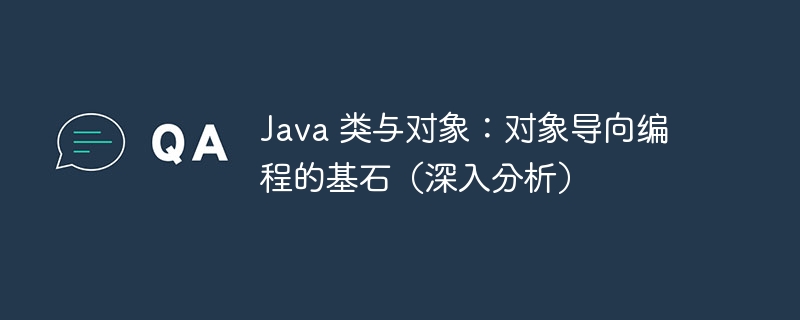Home >Java >javaTutorial >Java Classes and Objects: The Cornerstone of Object-Oriented Programming (In-depth Analysis)
Java Classes and Objects: The Cornerstone of Object-Oriented Programming (In-depth Analysis)
- WBOYWBOYWBOYWBOYWBOYWBOYWBOYWBOYWBOYWBOYWBOYWBOYWBforward
- 2024-03-11 09:10:21532browse

Java Classes and objects are the basis of object-oriented programming. Mastering this concept is crucial for Java programmers. In this article, PHP editor Xiaoxin will deeply analyze the relationship between Java classes and objects to help readers better understand the principles and applications of object-oriented programming. Through the analysis of concepts such as classes, objects, methods, etc., readers will be able to better grasp the essence of Java programming and improve their programming skills.
Class: Blueprint of the object
A class is a template that describes a group of objects with the same characteristics and behavior. It defines the object's properties (data members) and methods (behavior). Classes are abstract concepts and cannot be instantiated directly.
Create class:
class Employee {
private String name;
private int age;
private double salary;
// 构造函数
public Employee(String name, int age, double salary) {
this.name = name;
this.age = age;
this.salary = salary;
}
// 方法
public String getName() {
return name;
}
public void setName(String name) {
this.name = name;
}
// 省略其他方法
}
Object: instance of class
An object is an instance of a class, which contains all properties and methods of the class. Objects can be created by using the keyword new.
Create object:
Employee employee1 = new Employee("John", 30, 50000.0);
Employee employee2 = new Employee("Mary", 25, 40000.0);
Encapsulation: Hide internal implementation
Encapsulation is a principle of encapsulating data and methods in classes to hide their internal implementation. Access to properties and methods can be controlled by using access modifiers (public, private, protected).
Inheritance: Code Reuse
Inheritance allows one class (subclass) to inherit properties and methods from another class (parent class). This helps with code reuse and polymorphism.
Create subclass:
class Manager extends Employee {
private String department;
// 构造函数
public Manager(String name, int age, double salary, String department) {
super(name, age, salary);
this.department = department;
}
// 方法
public String getDepartment() {
return department;
}
// 省略其他方法
}
Polymorphism: Dynamic method binding
Polymorphism allows an object to call its methods with its actual type. For example, a subclass object can call parent class methods, but a parent class reference cannot call subclass methods.
Demo polymorphism:
Employee employee = new Manager("John", 30, 50000.0, "Sales");
// 调用父类方法
System.out.println(employee.getName());
// 调用子类方法
System.out.println(((Manager) employee).getDepartment());
in conclusion
Classes and objects are the basic building blocks of OOP in Java. Understanding how to define, create, and use them is critical to developing high-quality Java programs. Concepts like encapsulation, inheritance, and polymorphism help create reusable, maintainable, and extensible code. With a deep understanding of these concepts, Java developers can create efficient and robust applications that adhere to modern Software Development principles.
The above is the detailed content of Java Classes and Objects: The Cornerstone of Object-Oriented Programming (In-depth Analysis). For more information, please follow other related articles on the PHP Chinese website!

